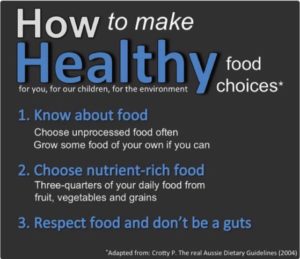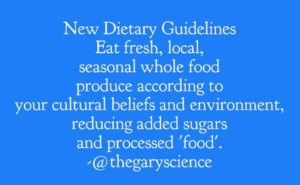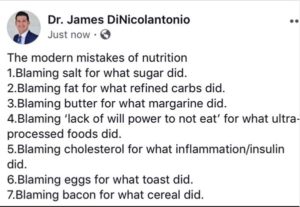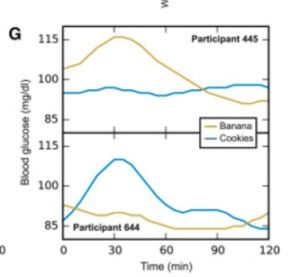
The ‘Diet Wars’ are always thriving on social media. You might wonder, how can it be that highly educated and intelligent people will argue until they’re blue in the face about, say, the virtues of eating eggs? Is it alright to have carbs from natural sources like fruit? Or potatoes? What about wholegrains? What about my microbiome?? In the last 2 posts in this series, I have talked about how we came to be in a state of mismatch between what appears to be on the one hand, an ideal eating pattern for human health and on the other hand, our current Nutrition Guidelines. I focussed on the two major ‘sticking points’ between these paradigms: advice relating to saturated fat and advice relating to ‘whole grain’ carbohydrate-rich foods.
With any criticism of the current Dietary Guidelines, the ‘powers that be’ will retort by asking: Well, what solution would you suggest to improve public health nutrition policy? In this post I’m going to outline what my response would be.
When we consider this question, the first important distinction to make is: are we are talking about recommendations for the population? Or an individual?
Nutrition advice for the population
When we are considering nutrition recommendations for the population, few of the general public realise that when guidelines are devised, they take into account a significant amount of non-science or health related issues. You’d be surprised by the weight of these non-health related considerations. For instance, public health nutrition guidelines need to consider the deliverability of any recommendations to the population. Take the example of fruit. The advice to include 2 pieces of fruit per day for the population was controversial at the time, as it was borderline if the food supply could provide 2 pieces per every individual in Australia (I think the calculation back when I sat in this lecture during my Nutrition and Dietetics degree in the early 2000’s was that only 1.8 pieces of fruit were available for each person). This caused the panel who reviews the guidelines (one of who was my lecturer at the time), much angst. In fact, the issues of food supply and distribution are, I believe the major road-blocks to meaningful change of the Guidelines towards a direction that is more focussed on real food, and less on packaged and processed foods. However, even though fixing this issue is extremely challenging, and involves several non-food and health related sectors (like agriculture, transport, the environment), this shouldn’t be a reason to not even try or to simply maintain the status quo.
Another important point to consider when we’re thinking public health nutrition guidelines, is to take into account the overall health of the population. How far is it from ideal? Let’s face it: while we’ve had advances in some areas of medicine in recent decades (through for instance improved technology), public health nutrition has failed dismally to curb the tsunami of chronic disease and the situation is growing exponentially worse. 2/3 of the population are overweight or obese and likely a similar proportion (at least) are insulin-resistant which is a strong driver of these chronic diseases [1]. The current version of the Guidelines, while quietly backing away from the insane amounts of carbohydrates that were recommended in the 90’s, haven’t gone far enough to reverse the pandemic of insulin resistance alive today in our society.
Now, let’s consider some examples of what could be an improvement on the Australian Dietary Guidelines. Let’s take the Guidelines in Brazil, for example. While I wouldn’t say these are perfect (because they still unfairly demonise saturated fat without good evidence), they do emphasise basing the diet on unprocessed foods, as well as the importance of home cooking and the social aspects of eating. These are such important determinants of health that have been overlooked by past versions of our Guidelines.
In social media circles, some have offered their opinion on what simplified nutrition guidelines could look like.

Melanie Voevodin, Dietitian and Health Economist adapted this into a Tweet-sized simple message (she’s since updated her view on the grains bit, but you get the idea!)

Gary Fettke, the Tasmanian Orthopaedic Surgeon who caught fire for recommending to his diabetic patients, came up with this simple but effective slide.

James DiNicolantonio has written books and papers about nutrition and is well worth checking out. I love this summary of Modern Nutrition Mistakes he posted on Instagram.
Yes, all a bit tongue-in-cheek. But do you ever let your mind wander into the land of ‘What If’? What if we saved millions of dollars of taxpayer money and the time of dozens of ‘experts’ and pared our Nutrition Guidelines to something really simple? What if we took all the power away from food industry by not demonising individual nutrients and instead put the focus on whole natural foods? Wouldn’t the infrastructure be obliged to respond?
The main question comes back to this: why do we need a government authority to tell us what to eat? This type of government-led nutrition advice is a very new phenomenon in the context of history. As you can see from this photo in the 1970’s, most of the people in this shot were looking quite a healthy weight.

These people don’t look worried about their lack of government-derived guidelines.
But, as I outlined in part one of this series, middle aged men, including the then President of the United States, Dwight Eisenhower were having heart attacks at an increasing rate and the pressure was on to find out why, and how to prevent it. We can see now the unintended negative effects of this advice.
Nutrition advice for individuals
So how should we interpret guidelines or even information we read about on the internet into good nutrition advice for each of us as individuals?
Well, once again you need to take stock of where you are at the moment. Where is your health right now? How are your energy levels and mood? Can you do the things you really want to do? If the answer is yes to these questions, chances are your diet and overall lifestyle probably aren’t far off where they need to be. And you might eat a low carb diet, a vegetarian diet or even possibly a ‘good’ version of our current Dietary Guidelines. (Yes, this is possible!). And that’s great! Carry on with your current nutrition approach, along with regular movement, paying attention to stress and sleep and good social relationships. You’ll have every chance of living a long and happy life.
But if you’re like the majority of adults, chances are your health isn’t quite where you want it. You might be carrying more weight than you’d like, you have aches or pains or for any number of reasons, you can’t do the activities you used to enjoy. If that is the case, my friend, it’s time to get the self-magnifying glass out. Don’t accept these niggles or in some cases fairly major health concerns as a normal ‘part of ageing’. They are not normal, but they are so commonplace we’ve come to the conclusion they are. There are several examples of people living in Blue Zone communities and tribes remote from Western Society who live long and productive lives well into their ninth and even tenth decades, almost completely absent from the afflictions that effect we westerners.
The most obvious area to examine why this is, is of course, diet. Have you followed the low-fat diet advice for years? Used margarine instead of butter for your heart? Have you been limiting egg yolks because of their cholesterol content? If you say yes, I’m afraid you’ve been the victim of the worst public health disaster ever. And your current health woes are probably largely due to what you’ve been told to eat for the past few decades. Unfortunately the advice you’ve been told will in fact, likely shorten your life and increase your risk of getting chronic diseases like heart disease and diabetes. If you’re angry about this, you should be. I am.
So what should you do to make improvements? If you know absolutely anything about me of have had even a cursory look at this website, you’ll know that I’m a big advocate for most adults to reduce their intake of sugar, refined carbohydrates and generally most foods that come out of a box or a through a drive-through window. I’d like to see people replace these with fresh, seasonal, local, unprocessed foods. Even if these foods contain natural fats. Exactly how this broad advice will apply to you will obviously vary based on the nuances of your situation. One handy tool that is available to help is the nutrient optimiser tool https://nutrientoptimiser.com and website. This allows you to enter your goals, characteristics and preferences into an algorithm that will help you determine which foods to focus on to make up a high proportion of your intake. The foods recommended are highly nutrient dense, so it makes sense to use these lists as a guide to make up the majority of what you eat on a daily basis. But really, any fresh, unprocessed food will do and likely be a massive improvement.
It is important to note here, that there are genetic and probably microbiome variations that will influence how the body will respond to certain foods. This study [2] published in Cell shows the wide variation in blood sugar response people with have in response to an array of different foods. See this example of a banana causing a huge glucose response in one subject vs a very modest response in another individual.

Glycaemic response of eating a banana in one individual (yellow line in the top graph) compared to another (bottom graph).
Make up the majority of what you eat based on whole, unprocessed foods that also provide high amounts of micronutrients. That is, animal foods like fish and eggs, and above ground veg like kale and spinach. Try and determine the state of your metabolic health at the moment (which, if you are unsure a simple measurement of waist and height and calculation of the ratio should help you determine. Ideal for this ratio is close to 0.5). Get some simple fasting blood tests ordered through your GP, which can tell you a lot. This will give you a baseline. Then, experiment with refining the frequency of certain ‘grey-area’ foods (like dairy, higher sugar fruits and starchy veg) within this framework. For instance, for someone with Type 2 diabetes, it would not be a good idea to consume bananas regularly. In contrast, someone who is metabolically healthy and physically active could consume bananas more frequently without damaging their health too much. No one across the board should be consuming a high amount of processed or junk foods regardless of how fat or skinny or active they are if they are serious about their long-term health.
Depending on other aspects of your health and situation, you might want to consider tweaking things a bit further. For example, there have been multiple anecdotes of people with autoimmune diseases improving their health by significantly limiting plant foods and largely eating a carnivore diet. Yes, that means a diet consisting almost entirely of animal foods. Think steak cooked in butter, eggs and not much else. Sounds crazy? Maybe. There are a number of cases, like Mikhaila Peterson who had debilitating Rheumatoid Arthritis and had a complete health turn around by adopting a carnivore diet. No-one can deny or detract the benefit this type of diet has had for individuals like this. But for others, making changes this significant is too much a cost to pay, they get overly stressed with this level of dietary restriction and the returns start heading in a negative direction. To come to that point is a very personal decision only you can make based the full array of your individual circumstances. For someone who is absolutely debilitated by their autoimmune disease and desperate to try anything, that balance of risk to gain could be positive. To others, it could be negative and they might choose to continue with a more traditional medical model to manage their condition, and that’s fine.
(For the record, my stance on the carnivore diet is I’m not convinced it is completely safe in the long term. There are no examples of populations that have thrived eating only meat, even the Inuit would consume some plant material when their environment allowed. But I’m happy to support people using it in a somewhat temporary basis as an elimination diet to try and improve certain autoimmune diseases, with a view to try and introduce a wider variety to the diet down the track. Folate, vitamin C and calcium are some nutrients I worry about in the longer term for carnivore dieters.)
To me, it makes sense to look at the best foods to eat from an evolutionary perspective. Several lines of evidence (outlined in these blog posts from Dr Sarah Ballantyne PhD) point to the fact that humans are innate omnivores, so for most people some variation of a paleo / low carbohydrate (by our moderns standards) diet that includes some plant and animal foods is your best bet. If your gut and body have been damaged by such a degree by our modern western food and lifestyle, and/or you have a debilitating autoimmune disease that is significantly impacting on your quality of life and you are motivated to try a nutritional approach, it could be reasonable to try a version of an Auto Immune Protocol or even a carnivore diet. You should do this in conjunction with a health professional who is familiar with nutritional monitoring and the concepts of these approaches.
Can I ever eat a slice of birthday cake again?
Probably yes. Something like a slice of cake or some other item of ‘junk food’ could probably be consumed at some point. But not ‘in moderation’. Because, what the hell does that mean? I would definitely recommend to save these occasions for a social occasion in the company of people you love, rather than alone at your desk, for instance. Adjust the frequency of these occasions to fall in line with your current health status and likely health trajectory. For example, if you have just been diagnosed with Type 2 Diabetes and are starting to make a dietary change, there’s no getting around the fact that having the view to pretty much eliminate these foods is the best view to take for the time being. Take that view and if there is a very rare slip up, it’s not the end of the world. Think of it like when you’re teaching your four-year old to cross the road. “you must stop at the edge of the road and you must NEVER cross the road unless you’re holding a grown-up’s hand”. Now, you and I know that EVENTUALLY that four year old will reach sufficient maturity to cross the road on their own. But for all intents and purposes and for safety reasons, you want the message for the time being to be “you must NEVER cross the road on your own”. In some ways as someone with a condition like Type 2 Diabetes, you need to talk to yourself like a four year old. This will give you the best chance of reversing your condition, if that’s important to you.
And don’t forget, these sugar-laden highly processed junk foods aren’t actually food. They are more like a drug in how they act in the brain and their addictive qualities. Let’s treat them that way. Consider alcohol. Yes, it can be enjoyed. Yes, it provides calories. But to subsist on it as anything more than a decent proportion of total calories consumed from alcohol and your health will quickly suffer
What if you feel really strongly that eating animal products is harming the planet? What if you worry about animal welfare and because of this, eating animal products completely stresses you out?
There is ample evidence from any number of databases and nutrient tables that animal foods tend to be more nutrient dense than plant based foods. That is, you obtain more quality protein, healthy fats, B vitamins, magnesium, zinc and an array of other important nutrients in a much more bioavailable and calorie-efficient way than trying to obtain the same micronutrients by eating plant foods.
That being said, some people get genuinely stressed that consuming animal foods is contributing to harm to animals or the planet in general (which is not a view I agree with). The degree of this stress would likely negatively impact their health. So I have no qualms supporting people who wish to eat a vegetarian diet, or even vegan diet because for their values and culture. Live and let live, eat and let eat (and I expect the reciprocal attitude).
So there you have it. That’s my manifesto of what I consider the ideal human diet. The Brazil Dietary Guidelines hit close to the mark to keep a population healthy. But for a population that is largely NOT healthy even these might not be enough to adequately improve things and further refinements would be needed. But no matter what your approach is, everyone would be well served by eating within the context of a secure and supportive community as well as developing and maintaining their culinary skills.
In an upcoming post, I will outline a framework to help you decide if any health intervention is safe and worth pursuing for you as an individual in your own situation. Keep an eye out for it!
References:
- Crofts, C., Zinn, C., Wheldon, M., Schofield, G. 2015. Hyperinsulinemia: A unifying theory of chronic disease?. Diabesity 1(4): 34-43. DOI:10.15562/diabesity.2015.19
- Zeevi, D. et al. 2015 Personalized Nutrition by Prediction of Glycemic Responses. Cell 163(5): 1079-1094 DOI: 10.1016/j.cell.2015.11.001



